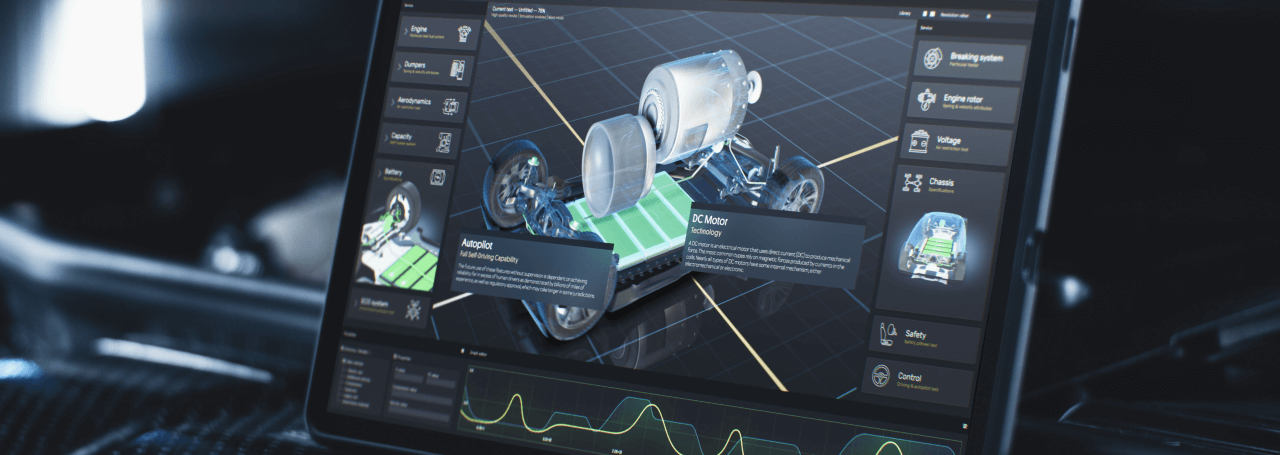- How does LCD display work? Technology basics
- Typical applications of LCD displays
- Why choose LCD technology? Advantages of LCD displays
- Challenges and limitations of LCD displays
- How is LCD technology developing? Innovations and future trends
- LCD, LED, OLED – which one should you choose? Comparison of display technologies
- Which LCD display should you choose for your project?
- Riverdi expert tips: 4 mistakes to avoid

How does LCD display work? Technology basics
Liquid crystal displays, known to all as LCDs, have revolutionized the way we view digital content. This phenomenon results from their specific technology based on manipulating the liquid crystals – substances that have properties between conventional liquids and solid crystals. These liquid crystals are sandwiched between two polarizing filters and electrodes. When electric current flows through liquid crystals, it changes their arrangement, also changing the intensity of light that can pass through them. This manipulation creates the images we see on the screen.
Color filters add RGB (Red, Green, Blue) components to each pixel. Advanced manufacturing techniques such as thin-film transistors (TFTs) enable control of every pixel for vivid and energy-efficient images. While other emerging display technologies, such as OLED and MicroLED, have advantages in specific applications, the capabilities, reliability, and cost-effectiveness of well-known LCD technology ensure its continuous prevalence in consumer and industrial applications.
Fun fact
LCD technology was invented in the 1960s and commercialized in the 1970s for calculator displays. Developments, such as active-matrix thin-film transistor (TFT) technology in the 1990s, made it possible to create color monitors for laptops and desktop computers. Today, LCDs are ubiquitous in consumer and industrial devices thanks to flexible production and affordable prices.
Typical applications of LCD displays
Now that we know LCD displays are used in many industries let’s look at the most popular ones and see what makes them so popular.
Consumer devices
LCD displays are thin and light, consume little power, and are easily readable outdoors compared to other types of displays. For this reason, they are commonly used in portable devices such as phones, tablets and laptops. They are also used in large-format TVs and desktop monitors. This is due to the great potential offered by high resolution and competitive prices.
Industrial and commercial devices
Everyday mobile devices are just one of many applications of LCD technology, which also works well in harsh industrial environments. Rugged LCD variants resist vibration, contamination, and temperature fluctuations in factory equipment, point-of-sale systems, automation control panels, and remote monitoring systems. Entrepreneurs choose them mainly because of their stability, many customization options, and prices that are becoming more and more affordable.
Automotive industry
For similar reasons, this type of display is also used in the automotive industry. Employees in this sector pay attention to shock and vibration resistance, which is why LCD displays are used in car entertainment and navigation systems. Plus, outdoor visibility, temperature resistance, and dimming management enable the use of displays on the dashboard and rear cameras.
Medical industry
In the medical sector, where precision and reliability are essential, medical-grade LCDs also play a crucial role. Their application is wide, from diagnostic imaging to visualization during surgical procedures. This is due to their ability to achieve high brightness and contrast, which is critical in bright lighting conditions of an operating theater. Additionally, their sharpness and high resolution make them ideal for applications such as surgical displays and patient monitors that need to present vital signs accurately.
Public space industry
Outdoor LCD displays also have an extensive range of possible applications in public spaces, e.g., providing real-time transport information, displaying advertising or wayfinding. Their sunlight readability, vandal-resistant options, and scalability to large formats mean they are often mounted in public places for information or commercial purposes.
Why choose LCD technology? Advantages of LCD displays
As you can see, multiple industries use LCDs for evident reasons. Here are the 3 most important advantages of this technology that you should know about.
Image quality
LCD displays provide excellent resolution, contrast, and color reproduction. Major manufacturers worldwide have applied this technology for over 30 years because it continues to deliver the stability and consistency of image quality they care about.
Thanks to local dimming, modern LCDs achieve 4K resolution and above and high contrast. They also guarantee accurate color reproduction covering over 100% of sRGB/AdobeRGB and full viewing angles (89/89/89/89). These parameters are the reason why LCD displays still outperform older CRT and plasma monitors.
Energy efficiency
LCD panels modulate the LED backlight rather than emitting light directly. This allows the backlight to be dimmed or turned off when displaying dark scenes or when the user’s attention is diverted. Thanks to this, energy consumption is reduced by over 90% compared to continuous operation.
Durability and reliability
Industrial-grade LCDs operate at temperatures from -20°C to +70°C. However, the extended models available in the Riverdi offer can also withstand temperatures from -30°C to 85°C and even from -40°C up to 110°C.
Notably, the protective metal casing and glued glass cover protect against vibrations, shocks, and contamination, allowing them to be successfully employed even in extreme conditions.
Additionally, displays with a backlight lifespan of 50,000-100,000 hours provide years of 24/7 operation, while consumer displays typically only last 20,000 hours (2.5 years).
Challenges and limitations of LCD displays
Although LCD displays offer several of the above advantages, you should be aware that they have several limitations. Check them out to maximize the benefits of LCD technology and avoid potential pitfalls.
Viewing angles
You must know that standard twisted nematic LCDs exhibit color and contrast changes at non-standard viewing angles. Therefore, if the device your team is working on will require operation from different positions, we recommend choosing advanced IPS (in-plane switching) panels that expand full viewing angles (89/89/89/89 or more), maintaining image accuracy.
Electromagnetic compatibility (EMC)
Some types of LCD displays are sensitive to interference from other electrical devices, which may make them difficult to use. Emissions and radiation resistance are critical to machine functionality, which is why Riverdi displays meet EMI limits. Thanks to this, you can use them without worrying about electromagnetic interference.
Reaction to temperature changes
If your team is developing a device that will be used in harsh conditions, e.g., in an industrial hall, please note that commercial panels are only suitable for operation at temperatures of 0°C-50°C. Riverdi industrial-grade displays, on the other hand, are built to withstand more demanding conditions. This ensures optimal performance and reliability in environments where temperatures can drop to -20°C, rise to +70°C and even go from -30°C to 85°C.
Size and flexibility limitations
You also need to know that compared to other technologies, the production of the LCD glass substrate limits the maximum size of the liquid crystal panel. Likewise, these displays are currently unable to match the capabilities of OLED and e-paper regarding material flexibility.
How is LCD technology developing? Innovations and future trends
Nowadays, where technological progress is changing our reality day by day, LCD technology is not left behind. Its evolution opens up new possibilities, not only in consumer electronics but also in industrial and professional applications. Therefore, in order not to be left behind and to be sure that you will use the best available technology for your project, it is worth knowing the key development directions of LCD displays. Here are the most important ones.
Higher resolutions
We have been observing the trend towards higher resolution for several years. For this reason, new generations of LCDs offer increasingly higher image quality, from 4K to 8K, moving to solutions offering resolutions of 16K and up. This makes it possible to create immersive environments and precise images for medical and scientific purposes.
Wider viewing angles
Manufacturers such as Riverdi constantly prioritize display comfort, which is why we are increasingly using technologies such as IPS and MVA. As a result, LCDs now offer much wider viewing angles than models based on the older TN technology.
Wider color range
Both electronic device manufacturers and users expect a wide range of saturated colors, which is why modern LCD displays currently achieve 90-95% NTSC color reproduction.
Integration with built-in systems
Users increasingly expect all-in-one displays integrating an LCD monitor with microcontrollers (like the STM32). In this regard, we can observe the development of panels that allow the creation of advanced devices with built-in computing power, memory, connectivity, and sensors – greatly simplifying system design.
Full Array Local Dimming (FALD)
This technology increases the contrast and energy efficiency of LCD displays by allowing the backlight to dim in dark areas of the screen. This is done for three reasons: to achieve better contrast, reduce energy consumption, and extend the life of the backlight, i.e., the display.
LCD, LED, OLED – which one should you choose? Comparison of display technologies
If you are faced with choosing which technology to select – LCD, LED, or OLED – the most important criterion you should consider is the device’s application.
When considering LED technology, remember that its strength lies in its ability to present vivid images and ensure fast response times, which can be crucial in specialized applications such as stage or studio displays. However, challenges such as higher power consumption and manufacturing complexity mean that LED is often reserved for more niche applications. Hopes are currently pinned on MicroLED technology, which will be distinguished by exceptional image precision, high contrast, and energy efficiency – but to popularize this solution, it is necessary to introduce cost-effective mass production.
OLED, on the other hand, with its self-illuminating pixels, offers infinite contrast and the ability to display true black. While these features may seem attractive, limitations related to durability and image burn-in can be problematic in many applications. Therefore, although OLED provides impressive image quality, it is best used in specific, specialized applications.
LCD technology, thanks to its versatility, resolution, brightness, and durability, remains the best choice for a wide range of applications. Its advantages in cost, reliability, and availability make it the dominant choice in the market. Therefore, LCD will be the safest and most cost-effective selection if you are looking for a display technology that balances image quality with long-term performance and economic efficiency.
Which LCD display should you choose for your project?
You already know what LCD technology is and why it remains popular despite the passage of time. If you are now wondering where to order a reliable LCD panel for your project, our team of experts has some tips for you. Check them and make sure that the manufacturer you trust meets the following requirements.
Long-term availability
Pay attention to whether the display will be available throughout the product’s lifecycle. The service life of an industrial device is typically 10-15 years, so the long-term availability of LCD displays is a huge advantage.
Integration and documentation quality
Look for well-documented displays supported by development boards and software libraries. Riverdi displays are tested to comply with EMI limits so they do not interfere with other devices, and these reports can be easily downloaded on individual product pages.
Adapting to individual needs
Standard displays meet the typical needs of most consumers, such as resistance to vibration and electromagnetic interference, compatibility with gloves, dust, and water resistance, high brightness for outdoor use, and vandalism resistance with protective glass. However, if the display for your device is to fulfill other functions, make sure that the manufacturer you choose can guarantee them.
Easy prototyping
If you want to start your project quickly, consider ordering small quantities of displays or prototype samples. Evaluation boards can also help reduce time to market. Both options are available at the Riverdi offer.
Personalization option
Are you in need of custom decorative glass with your company logo? If so, consider it early in the process. This also applies to other non-standard solutions that will be crucial for adequately functioning the end-user’s device. We are talking about functions such as operating the touch screen with gloves or using the device in direct sunlight.
Riverdi expert tips: 4 mistakes to avoid
We want to make sure that, thanks to this article, you will choose a display that will satisfy the requirements of both you and your end users. Therefore, finally, we present a list of 4 mistakes entrepreneurs often make when ordering a display for their first project. Avoid them and ensure reliable operation of your machines.
- Failure to consider the device’s final environment and requirements, such as sunlight.
- Insufficient EMC and EMI data for the device.
- Using consumer-grade touch controllers instead of industrial-grade.
- Poorly documented displays that cause market delays.
You didn’t find the answer to your question about LCD technology in the article?
Or maybe you need professional advice on selecting a specific type of display?
Please fill out the contact form and our team of experts will assist you in solving the problem.
DISCOVER OUR
Whitepaper
Achieve the perfect user-display interaction with the right Touch Sensor IC. Ever faced issues with phantom touch events or certification? Boost your R&D like a pro with our Whitepaper!


